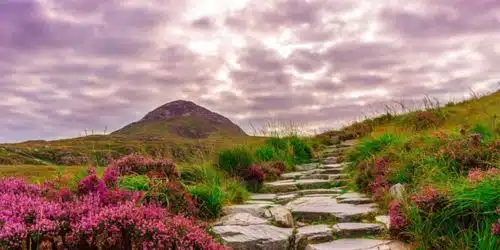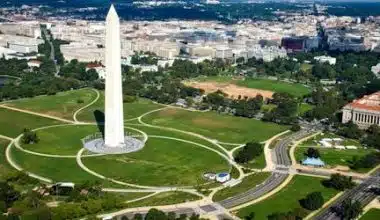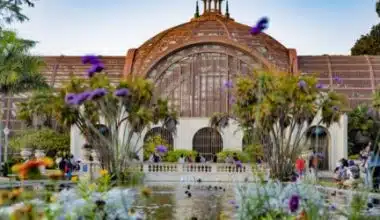If you’re wondering how many national parks there are in the US, this write-up explores the number of National parks in the US and the most important ones. The United States has a wealth of natural treasures, including national parks. These pristine, protected areas showcase the country’s breathtaking beauty, from towering mountains to vast deserts and lush forests to rugged coastlines.
How Many National Parks Are There in the US?
The United States is home to some of the most breathtaking natural landscapes in the world, and many of these areas have been designated as national parks. There are 63 designated national parks in the National Park System, which the National Park Service oversees.
List Of The Top National Parks In The United States
Here are the top national parks in the United States:
#1. Yellowstone National Park
Established in 1872, Yellowstone is widely considered the first national park in the world. Located in Wyoming, it also extends into Montana and Idaho. It is renowned for its geothermal features, including the famous Old Faithful geyser and the colorful Grand Prismatic Spring.
#2. Yosemite National Park
Located in California’s Sierra Nevada mountains, Yosemite is known for its stunning granite cliffs, waterfalls, and giant sequoia groves. It offers opportunities for hiking, rock climbing, and wildlife viewing, including the iconic Half Dome and El Capitan.
#3. Grand Canyon National Park
It is situated in Arizona. The Grand Canyon is a natural wonder that attracts millions of visitors each year. The Colorado River carved the canyon, which is well-known for its enormous size and striking, vibrant rock formations.
#4. Zion National Park
Zion is famous for its towering sandstone cliffs and narrow slot canyons. The park offers numerous hiking trails, including the popular Angels Landing and The Narrows. It is located in southwestern Utah.
#5. Rocky Mountain National Park
This park features breathtaking mountain landscapes, alpine meadows, and diverse wildlife. Rocky Mountain is situated in Colorado, Visitors can enjoy hiking, camping, and scenic drives along the Trail Ridge Road.
#6. Glacier National Park
Glacier is known for its pristine lakes, rugged mountains, and glaciers. The park located in Montana, offers stunning vistas, hiking trails, and opportunities for wildlife spotting, including grizzly bears and mountain goats.
#7. Acadia National Park
Acadia National Park is on Mount Desert Island in Maine. It is known for its rocky coastline, woodlands, and granite peaks. Visitors can enjoy hiking, biking, and scenic drives, as well as explore the charming town of Bar Harbor.
#8. Everglades National Park
The Everglades is the largest subtropical wilderness in the United States and it is situated in southern Florida. It is home to a unique ecosystem of wetlands, sawgrass marshes, and diverse wildlife, including alligators and manatees.
#9. Great Smoky Mountains National Park
The Great Smoky Mountains is the most visited national park in the United States. It straddles the border of Tennessee and North Carolina. Great Smoky Mountains National Park is known for its ancient mountains, diverse plant and animal life, and picturesque landscapes.
#10. Arches National Park
Arches National Park is famous for its unique rock formations, including over 2,000 natural sandstone arches. The park has numerous hiking trails and scenic viewpoints, showcasing the stunning red rock landscapes.
#11. Olympic National Park
The Olympic National Park in Washington State features diverse ecosystems, ranging from rugged coastlines and temperate rainforests to alpine meadows and glacier-capped mountains.
#12. Joshua Tree National Park
Right in California’s Mojave Desert, Joshua Tree National Park is characterized by its unique Joshua trees and large boulder formations. The park offers opportunities for hiking, stargazing, and rock climbing, showcasing the desert landscapes.
#13. Bryce Canyon National Park
Bryce Canyon National Park is known for its distinctive rock formations called hoodoos. These tall, thin spires of rock create a surreal and otherworldly landscape. It is situated in Utah.
#14. Hawai’i Volcanoes National Park
The Big Island of Hawaii has a park that showcases the power and beauty of active volcanoes. Tourists can witness lava flows, explore hiking trails, and learn about the geological and cultural significance of the Hawaiian islands.
#15. Denali National Park
Denali National Park is home to the highest peak in North America, Mount Denali (formerly known as Mount McKinley). The park offers vast wilderness, diverse wildlife, and opportunities for mountaineering, wildlife viewing, and scenic flights.
Features of National Parks in the US.
National parks in the United States are known for their diverse and unique features, which can include natural landscapes, geological formations, historical sites, wildlife, and recreational opportunities. National parks have their unique combination of natural wonders, cultural heritage, and recreational opportunities, making them valuable and cherished destinations for visitors from around the world.
#1. Beautiful Landscapes
National parks often showcase breathtaking landscapes, ranging from majestic mountains to vast canyons, pristine beaches to dense forests. Examples include the Grand Canyon in Arizona and Yosemite National Park in California.
#2. Geological Wonders
Many national parks exhibit fascinating geological formations. This can include towering rock formations like those found in Arches National Park in Utah, or massive calderas like the one in Yellowstone National Park.
#3. Wildlife
National parks provide habitats for a wide variety of wildlife species. Visitors may encounter animals such as bears, wolves, elk, eagles, and more. Denali National Park in Alaska is home to diverse wildlife, including grizzly bears and caribou.
#4. Historic and Cultural Sites
Some national parks preserve important historical or cultural sites. The Independence National Historical Park in Pennsylvania protects significant sites related to American independence, including the Liberty Bell and Independence Hall.
#5. Recreation Opportunities
National parks offer numerous outdoor activities for visitors to enjoy, such as hiking, camping, birdwatching, fishing, and kayaking. Olympic National Park in Washington State provides opportunities for hiking, backpacking, and exploring coastal and mountainous areas.
#6. Protected Ecosystems
The preservation and protection of many habitats, such as wetlands, forests, deserts, and coral reefs, is greatly aided by National parks. The greatest subtropical wilderness in the United States is preserved in Florida’s Everglades National Park.
#7. Educational and Interpretive Programs
To educate visitors about the park’s natural and cultural features, National parks frequently provide educational programs, guided tours, and interpretive exhibits. These programs offer insightful information about the history, geology, and ecology of the park.
#8. Waterfalls
Numerous national parks are home to breathtaking waterfalls. Yosemite National Park in California boasts famous waterfalls like Yosemite Falls, Bridalveil Falls, and Vernal Falls. Great Smoky Mountains National Park in Tennessee and North Carolina is also known for its cascading waterfalls.
#9. Caves
Several national parks feature caves that offer unique underground experiences. Carlsbad Caverns National Park in New Mexico is famous for its vast underground chambers and stunning cave formations. Visitors can take guided tours to explore these subterranean wonders.
#10. Ancient Ruins and Petroglyphs
Some national parks, such as Mesa Verde National Park in Colorado and Bandelier National Monument in New Mexico, preserve ancient ruins and petroglyphs that provide insights into the lives of early civilizations.
Regulations Guiding National Parks in the US
National parks in the United States are governed by various regulations to ensure the protection and preservation of these natural and cultural treasures. Visitors need to familiarize themselves with the regulations specific to each national park they plan to visit. These regulations not only protect the natural and cultural resources within the parks but also contribute to a safe and enjoyable experience for all visitors.
The Regulations that guide national parks are
#1. Wildlife Protection Regulations
National parks prioritize the conservation of wildlife. Visitors are required to follow strict guidelines to ensure their safety and the well-being of the animals. Approaching or disturbing wildlife is strictly prohibited to prevent harm to both visitors and the animals.
#2. Air Quality Regulations
The U.S. Environmental Protection Agency (EPA) implements regulations to maintain air quality in and around national parks. This includes controlling emissions from nearby industries and monitoring air pollution levels to preserve the pristine environments within the parks.
#3. Leave No Trace Principles
The Leave No Trace principles are guidelines that promote responsible outdoor behavior. These principles emphasize minimizing one’s impact on the environment, including proper waste disposal, respecting wildlife and vegetation, and staying on designated trails to avoid damaging sensitive ecosystems.
#4. Fishing Regulations
The control of fish populations and the preservation of aquatic ecosystems are among the objectives of the regulations that apply to fishing in national parks. These rules frequently include limitations on fishing gear, catch ceilings, and set fishing zones.
Businesses and individuals conducting commercial activities within national parks must obtain Commercial Use Authorizations (CUAs) and adhere to relevant laws, public health orders, and guidance.
#6. ADA Accessibility Guidelines
National parks strive to provide equal access to all visitors, including individuals with disabilities. The Americans with Disabilities Act (ADA) sets guidelines for accessibility in public places, including national parks, ensuring that facilities, trails, and services are accessible to all.
#7. Camping Regulations
Camping regulations vary among national parks. They include guidelines for campsite selection, fire safety, waste disposal, and camping permits. These regulations help manage visitor impact and protect the park’s ecosystems.
#8. Firearm Regulations
National parks follow federal laws regarding the possession and use of firearms. While some parks allow visitors to possess firearms by state laws, it is vital to understand the specific regulations of each park to ensure compliance.
#9.Archaeological and Cultural Site Protection
Regulations governing national parks emphasize the protection of archaeological sites and cultural resources. Visitors are prohibited from removing artifacts or damaging cultural structures to preserve the integrity and historical significance of these sites.
#10. Noise Regulations
National parks aim to provide a peaceful and natural environment for visitors. Noise regulations include restrictions on loud music, excessive noise from vehicles, or the use of generators to maintain the tranquility of the park.
What Is The Largest Us National Park?
The largest national park in the United States is Wrangell-St. Elias National Park and Preserve in Alaska. It spans over 8 million acres (32,375 square kilometers), making it larger than each of the nine smallest states in the US. Wrangell-St. Elias National Park and Preserve is known for its diverse ecosystems, including temperate rainforests, glaciers, and tundra. It is home to an incredible variety of wildlife, including grizzly bears, wolves, moose, and Dall sheep.
Which Of The 50 States Has The Most National Parks?
California has the most national parks among the 50 states, with a total of nine national parks. Alaska comes in second with eight national parks.
Which Country Has The Most National Parks?
Australia has the most national parks in the world, with over 600 national parks. Other countries with a significant number of national parks include China with 208 national parks, Thailand with 138 national parks, India with 102 national parks, and Israel with 69 national parks. Some countries have a higher percentage of their land area set aside as protected reserves, such as Seychelles with 42% of its territorial area being protected as national parks and reserves, and Namibia with 43% of its territorial area under conservation management.
How Many National Parks Are There In The UK?
There are 15 national parks in the United Kingdom. England has 10 national parks, Wales has three national parks, and Scotland has two national parks. These national parks cover a significant portion of the land area in the UK and are designated as protected landscapes due to their special qualities and natural beauty.
Which Is The Smallest US National Park?
The smallest national park in the United States is Gateway Arch National Park in Missouri. Formerly known as the Jefferson National Expansion Memorial, it covers an area of 192.83 acres (0.78 square kilometers). Gateway Arch National Park is located in downtown St. Louis and is known for its iconic Gateway Arch, which stands as a symbol of westward expansion in the United States.
Which State Has The Most National Parks?
California has the most national parks with a total of nine national parks.
Conclusion
The top national parks in the United States include Yellowstone is the first national park in the world, known for its geothermal features. Yosemite is renowned for its granite cliffs, waterfalls, and giant sequoia groves. The Grand Canyon is a natural wonder in Arizona, known for its immense size and colorful rock formations. Zion National Park is known for its towering sandstone cliffs and narrow slot canyons. Rocky Mountain National Park offers breathtaking mountain landscapes, alpine meadows, and diverse wildlife. Glacier National Park in Montana offers pristine lakes, rugged mountains, and glaciers.
- HIKING TRAILS COLORADO SPRINGS IN 2023
- BEST PORTUGAL TRIPS AND TOUR PACKAGES
- TRAVEL-INSURED INTERNATIONAL 2023 REVIEWS
- BEST DESTINATIONS FOR VACATION IN AFRICA
- THE BEAUTIFUL MOUNTAINS IN CANADA: Facts & History






